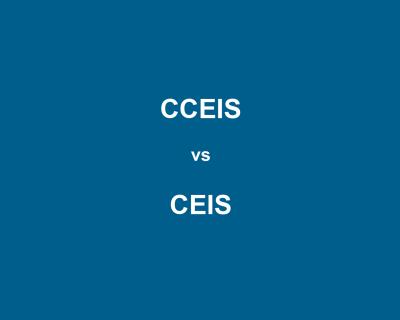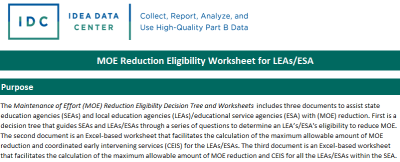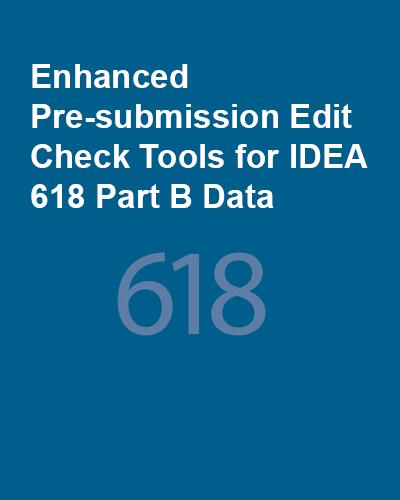
Resource Library
Guides. Briefs. Toolkits. Quick reference information. IDC and its partners created these data quality resources to help states better prepare to address their existing or emerging IDEA data quality needs. Use our search and filtering tools to navigate the library.
Resources 1 - 7 of 8
Format: Quick Reference
618 Data Collection and Submission TimelineA graphic illustrating how different IDEA data collections can span multiple years and how a state may be working simultaneously with data from multiple school years.
Format: Applications and Spreadsheets
618 Data Collection CalendarWho doesn't love a good calendar? This tool serves as a reference for states as they plan for the timely and accurate submission of their 618 data collections. Simply select a month to view the data collection and corresponding tasks and activities for that month, or select a report to view a monthly breakdown of activities and related resources.
Format: Quick Reference
A Comparison of Mandatory Comprehensive Coordinated Early Intervening Services (CCEIS) and Voluntary Coordinated Early Intervening Services (CEIS)In December 2016, OSEP finalized new regulations on significant disproportionality (34 CFR §300.646). These regulations enforce the use of IDEA funds for mandatory CCEIS, which LEAs provide upon identification of significant disproportionality, and distinguish use of funds for CCEIS from the use of IDEA funds for voluntary CEIS. This resource is a handy chart that outlines the differences between CCEIS and voluntary CEIS.
Format: Applications and Spreadsheets
Coordinated Early Intervening Services (CEIS) Fiscal and Student Data TrackerThe Coordinated Early Intervening Services (CEIS) Fiscal and Student Data Tracker is a set of four tools SEAs can use with their districts, schools, and providers to assist them in tracking the finances, services, and student data associated with CEIS. IDC and CIFR produced the CEIS Tracker. The resource also includes an instructions document or user's guide for more information about when and how to use the CEIS Tracker.
Format: Applications and Spreadsheets
Data Sources for Calculating Significant DisproportionalityData Sources for Calculating Significant Disproportionality provides a summary of the data needed to calculate significant disproportionality for identification, placement, and discipline. For each category of analysis, this resource provides a description of the data needed to calculate the risk numerator and risk denominator, and notes the relevant EDFacts file specifications, including which subtotals or category sets, as appropriate.
Format: Applications and Spreadsheets
Maintenance of Effort (MOE) Reduction Eligibility WorksheetsThe Maintenance of Effort (MOE) Reduction Eligibility Worksheets includes two documents to assist SEAs and LEAs/ESAs with MOE reduction. The first is an Excel-based worksheet that facilitates the calculation of the maximum allowable amount of MOE reduction and CEIS for the LEA/ESAs. The second document is an Excel-based worksheet that facilitates the calculation of the maximum allowable amount of MOE reduction and CEIS for all the LEAs/ESAs within the SEA.
Format: Applications and Spreadsheets
SEA Edit Check and Data Display Tools for IDEA 618 Part B DataIDC presents the SEA Edit Check and Data Display Tools for IDEA 618 Part B Data to help states prepare their Part B data submissions. States can use these tools to review the contents of their IDEA 618 EDFacts Part B personnel, exiting, discipline and child count and educational environment data for children ages 3–5 (FS089) and students ages 6–21 (FS002) prior to submission to the EDFacts Submission System or ESS. The tools apply edit checks and identify potential errors in subtotals or totals in the data files. In addition, the tools provide user-friendly summaries of the 618 data. The tools are enhanced versions of the SEA Edit Check and Data Display Tools for personnel, exiting, discipline, and child count and educational environment data. The main difference is the enhanced edit check tools require states to directly copy and paste the EDFacts data files they will submit to ESS as opposed to manually entering data into an Excel file in a format that is different than the one required for submission to ESS.








